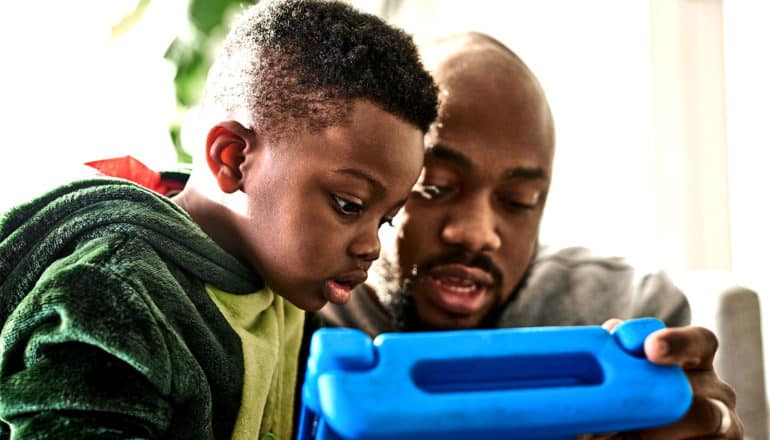
Digital storybooks that animate upon a child’s vocalization offer beneficial learning opportunities, especially for children with less developed attention regulation, researchers report.
“Digital platforms have exploded in popularity, and a huge proportion of the top-selling apps are educational interfaces for children,” says senior author Erik Thiessen, associate professor of psychology at the Dietrich College of Humanities and Social Sciences at Carnegie Mellon University.
“Many digital interfaces are poorly suited to children’s learning capacities, but if we can make them better, children can learn better,” Thiessen says.
Getting involved in learning
Shared book reading is a quiet moment that provides a child with the fundamental foundation for developing reading and language skills. The rise of digital platforms, like electronic books, computers, smartphones, and tablets, have raised concerns that children may be missing out on this key learning experience.
“Children learn best when they are more involved in the learning process,” Thiessen says. “It is really important for children to shape their environment through their behavior to help them learn.”
The researchers constructed the study in three parts that build on previous results. In the first experiment, an adult read to the child from either a traditional hardboard book or a digital book. In the digital platform, the pertinent noun/verb and a relevant image are animated upon the child’s first vocalization. They found the recall improved using the digital platform compared to the traditional book (60.20% to 47.35%, respectively).
“This kind of contingent responsiveness from our digital book (or from a parent or teacher) is rewarding. And reward has lots of positive effects on learning. As we get reinforcement, the brain releases dopamine that can serve as a signal for learning at the synaptic level,” Thiessen says.
“At the cognitive level, reward promotes maintenance of attention to help the child focus on what is important, which could be especially important for children who have less well developed attentional control.”
The second experiment delved deeper to evaluate whether the positive results from the first experiment were an artifact of the novel experience using a digital platform. The researchers compared two digital books—one static and one animated. Again, children’s recall improved using the animated digital platform (64.72% to 45.89%, respectively).
Finally, the researchers explored the role of animations in recall and attention. They compared two digital storybooks—one that animates at the start of the page and one that animates upon an appropriate child vocalization. Children’s recall was higher for the digital book that animated with the child’s vocalization (59.42% compared to 45.13%).
Controlling books for better recall
In every experiment, children experienced better recall for stories when they were able to exert active control on the animations in the storybook. According to Thiessen, positive reinforcement enhances the learning experience as do the animated visuals, which integrate nonverbal information and language into the mix. This approach was also particularly beneficial for children who experience difficulty focusing.
“Contingent positive reinforcement may be especially useful for children with lower attentional control because it facilitates learning by directing children’s attention to relevant content,” says first author Cassondra Eng, graduate student in Thiessen’s lab. “The contingent responses may provide children with feelings of accomplishment and may serve as positive reinforcement, which in turn enhance learning.”
Each experiment consisted of a unique cohort of approximately 30 young children (3-5 years old). For each iteration, the children were read two books (each 14 pages) following a structured approach by the adult reader. After the story, the researchers child was asked ten questions to evaluate story recall.
While this study found animated digital storybooks are beneficial for children, especially children with lower attention skills, the study did not explore why this approach proved to be advantageous. The study did require children to recall information through identification and description, which has proven to be a valid approach to identify a children’s competency in understanding the story.
Speech recognition software was inadequate to animate the digital platforms automatically. For the study, a researcher initiated the animations manually upon an appropriate vocalization from the child. Current work in the lab is focused on building an interface with fully automatic speech recognition capacities.
The results appear in Developmental Psychology.
Source: Carnegie Mellon University
The post Kids remember more from animated digital books appeared first on Futurity.
from Futurity https://ift.tt/34WHWMx
No comments:
Post a Comment